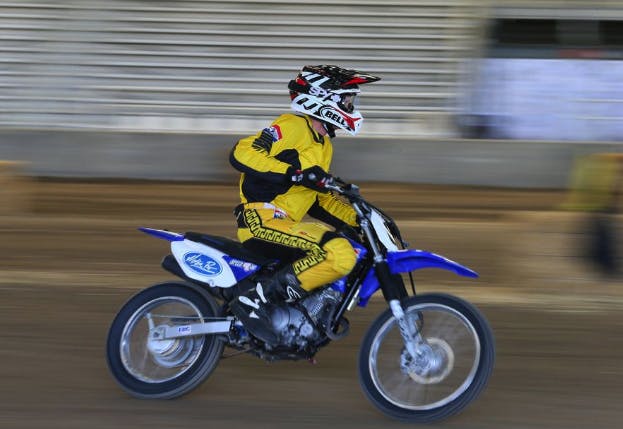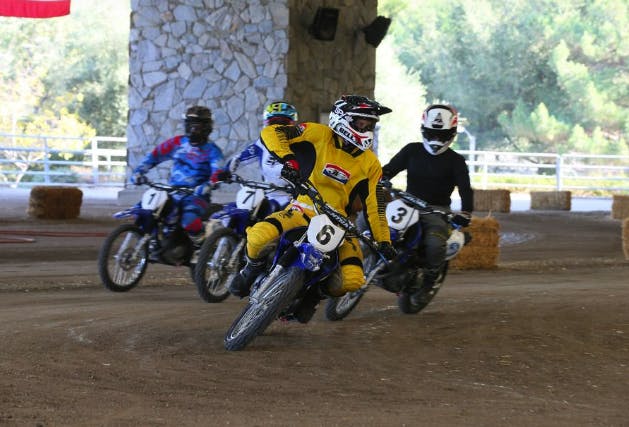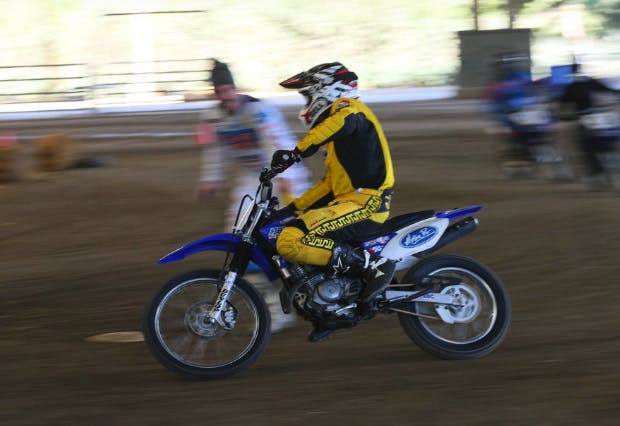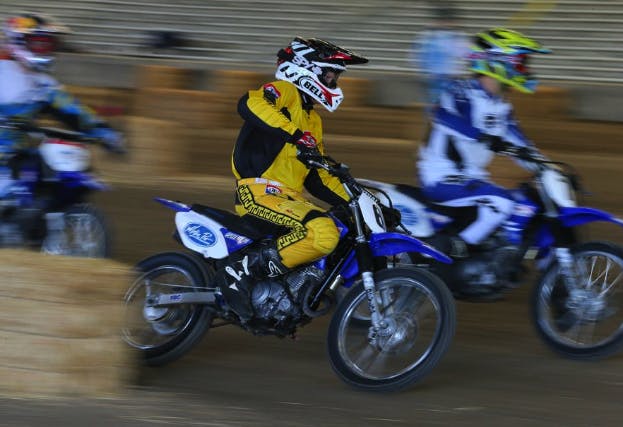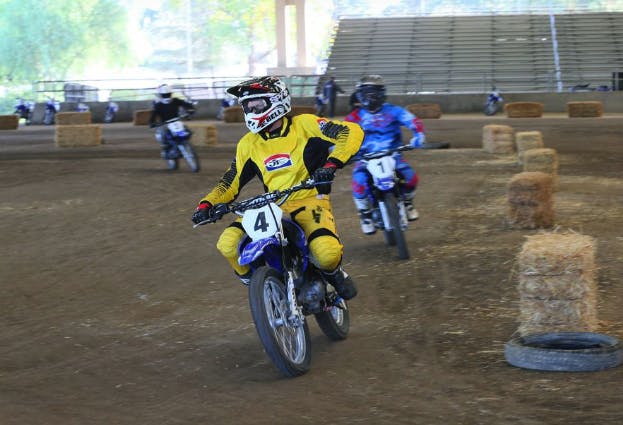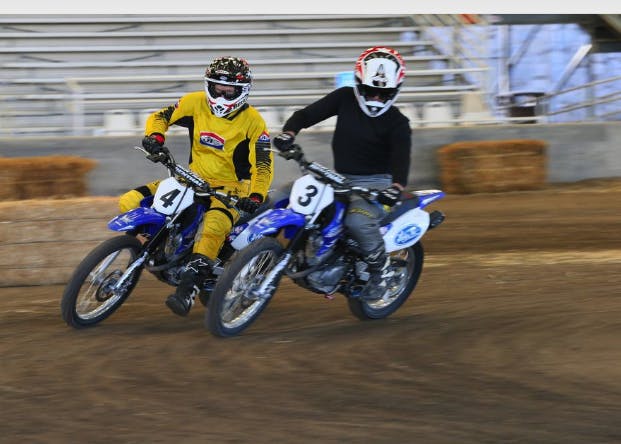All kinds of slideways: A motorcycle flat-track primer

If you subscribe to the behavioral theory that motor racing is a surrogate for instinctual pack hunting, American Flat Track (AFT) is the show to watch. Sanctioned by the AMA Pro Racing, AFT is like motorcycle road racing on dirt, with riders sliding around oval turns and then high-speed drafting down the straights. It’s utterly unique in the racing world—and so animalistic, you can almost smell the adrenaline, sweat and fear of your quarry.
And they, yours.
Go time: Astride your single-cylinder race-bike, which is equipped with asymmetrical dirt-track tires, you can feel the engine heat and vibration emanating from below, the exhaust shouting behind you. There are no gauges; you see only a gas tank, handlebar, clutch lever, throttle, and part of the fork and front tire. You’re enveloped in engine noise as you idle toward the grid—white chalk markings laid right on the dirt.
A very real ordeal

When an official turns the 30-second board sideways, the sound peaks like you’re on the wrong end of an air-raid. But you’re riveted on the flagman instead. He is motionless, like you. Like everyone on the track, your competitors, seated on their bikes. Engines and nerves are redlined. Then the flag whips; you pin the throttle and drop the clutch, feeling the rear wheel spin as you use body english to gain traction and keep the front tire down. Lifting your boots onto the pegs, you upshift and rush headlong into turn one, dirt lashing your helmet. In the corner, you rotate your pelvis inward and extend your left leg like a tiller, toward the inside of the corner, heel skimming the ground. Your left arm pushes down and your right elbow comes up, right hand still on the throttle. Your eyes pierce up and left, following the track. The back end of the bike fishtails as the tire finds, loses, and regains grip. Love video games? This one’s real.
120 years on
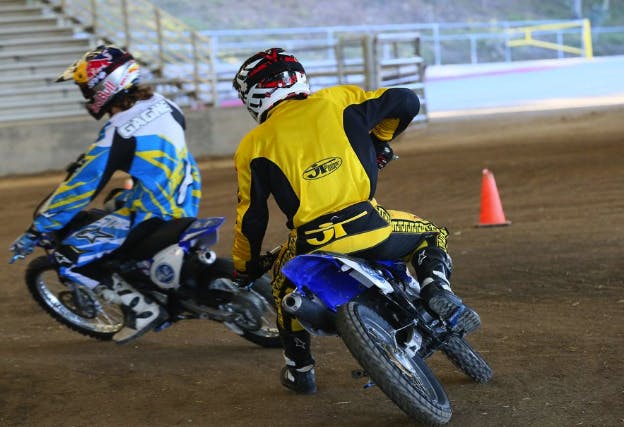
Dirt-track racing—largely synonymous with flat-track racing, at least on two wheels—has existed for over a century in America. According to the late Stephen Wright’s book American Racer: 1900–1940, the first organized races occurred around 1900. Dirt-track evolved into spectacular banked board tracks, high-speed ovals built of two-by-four lumber and the big stage for motorcycle racing, predating even the Indianapolis 500.

For motorcyclists, flat track was the premium form of motorcycle racing prior to World War II, and then also for two decades, it was an integral part of the AMA Grand National Championship—a high point in twentieth-century American bike racing. Another thing going for dirt-track racing is, well, the dirt. Whether you believe mankind rose from the primordial ooze or that we just like the spuds and sprouts grown in it, you have to admit that dirt is really Mother Earth, the cradle of life. Mixed in the right combination of limestone and clay, sand and loam, it packs down great, offers surprising grip, and shoots skyward in glorious rooster-tails when riders get on the gas.

Flat track racing features several disciplines: Short Track, for ovals as small as 1/8 mile; Half Mile ovals; and the Mile, the big daddy of the sport. The latter is seriously fast, with pros hitting 140 mph on the straights. Ideally, riders don’t brake on the ovals, and the race-bikes thus lack front brakes completely; their rear brakes are for gridding or stopping, and occasionally balancing the bike at speed. A spool hub, similar to those seen on early dragsters, typically serves up front. A fourth flat-track discipline, TT (Tourist Trophy), uses left and right turns and a jump, and requires bikes with front and rear brakes.
Places to play

American Flat Track is licensed by Daytona Motorsports Group, which is hell-bent on returning the series to prominence; races are broadcast on NBCSN. And for amateurs of all ages, amateur flat-track regionals and nationals occur around the country. The bikes are mostly contemporary dirt bikes, repurposed for the demands of a sport where weight and torque are used differently. That said, if you are more comfortable with older iron, the American Historic Racing Motorcycle Association (AHRMA) caters to vintage dirt trackers with a national Short Track and TT series focused in the Southeast and Midwest. AHRMA is a good place for new or returning riders interested in vintage bikes and dirt-track.
Virtually any classic dirt or enduro bike 1981 or earlier can be modified for use as a dirt-tracker. Before you jump in though, we recommend getting instruction such as at the American Supercamp Flat Track School, which uses genial 125-cc Yamaha TT-R125LE trail bikes as instructional tools. Thanks to the new skills you’ll learn, you’ll become a better street rider, too.
Flat Track quick hits

Feel like getting a little sideways and a lot dirty? Find out more about vintage and modern flat-track racing here:
American Supercamp Flat Track School

